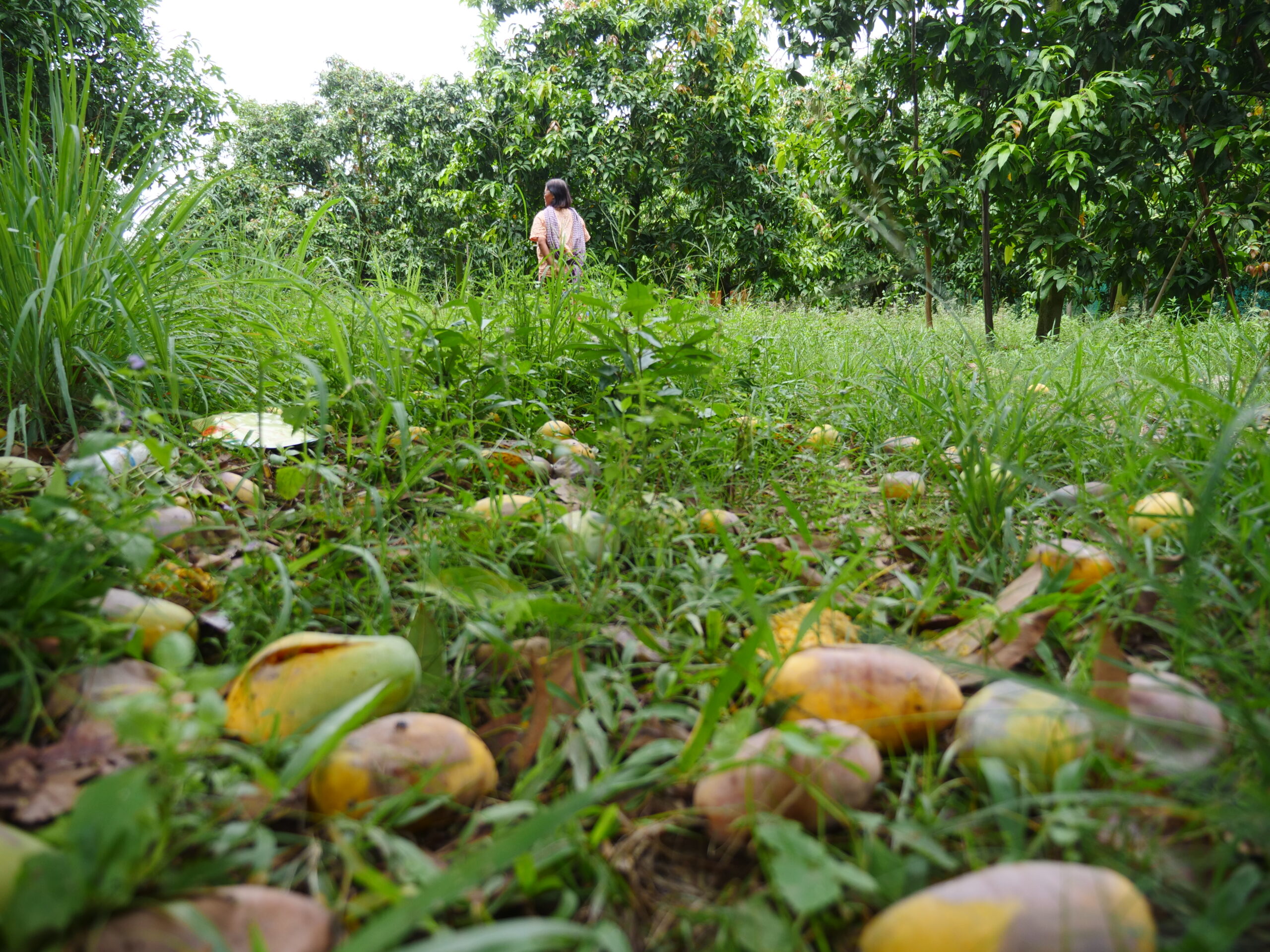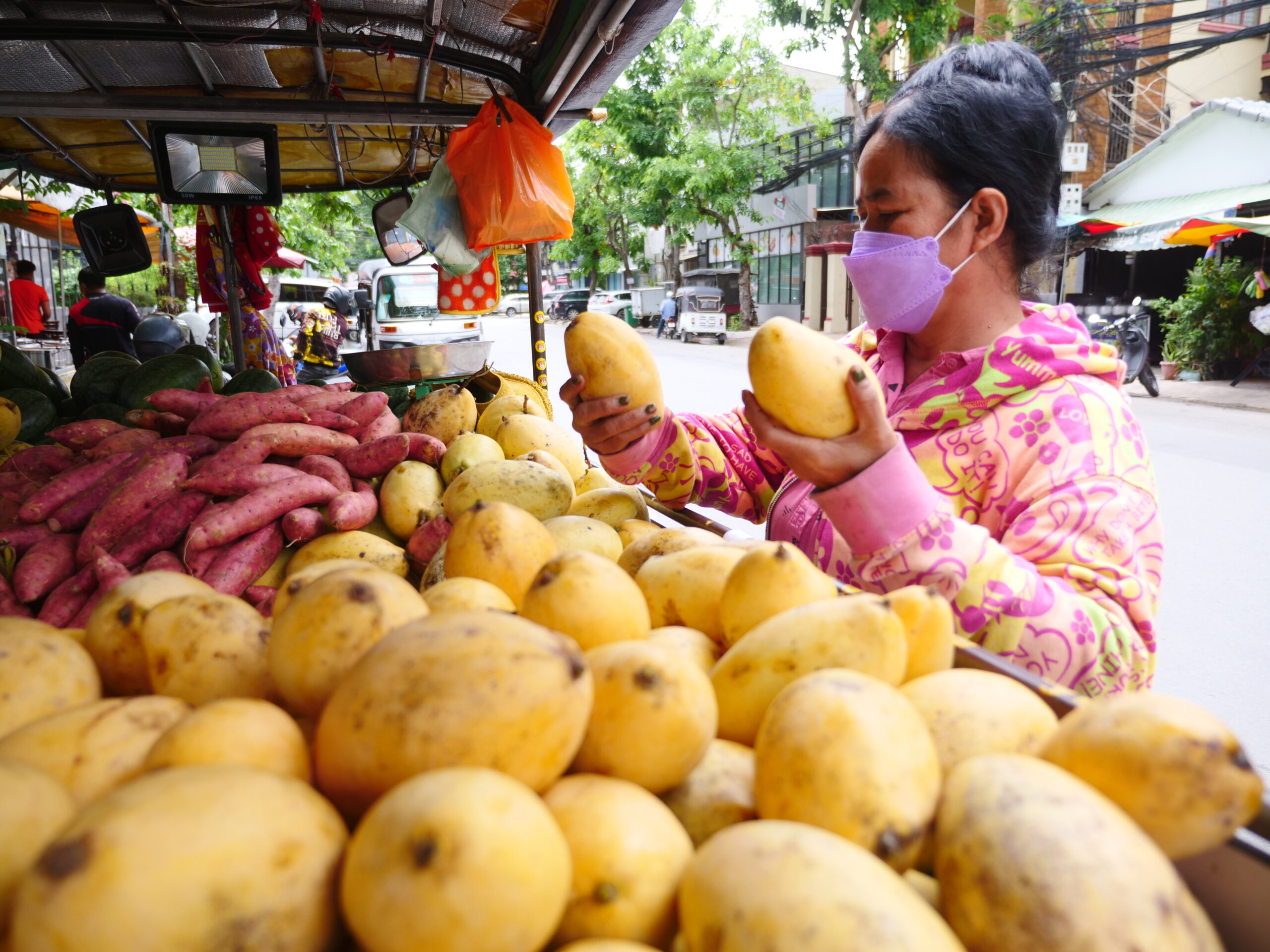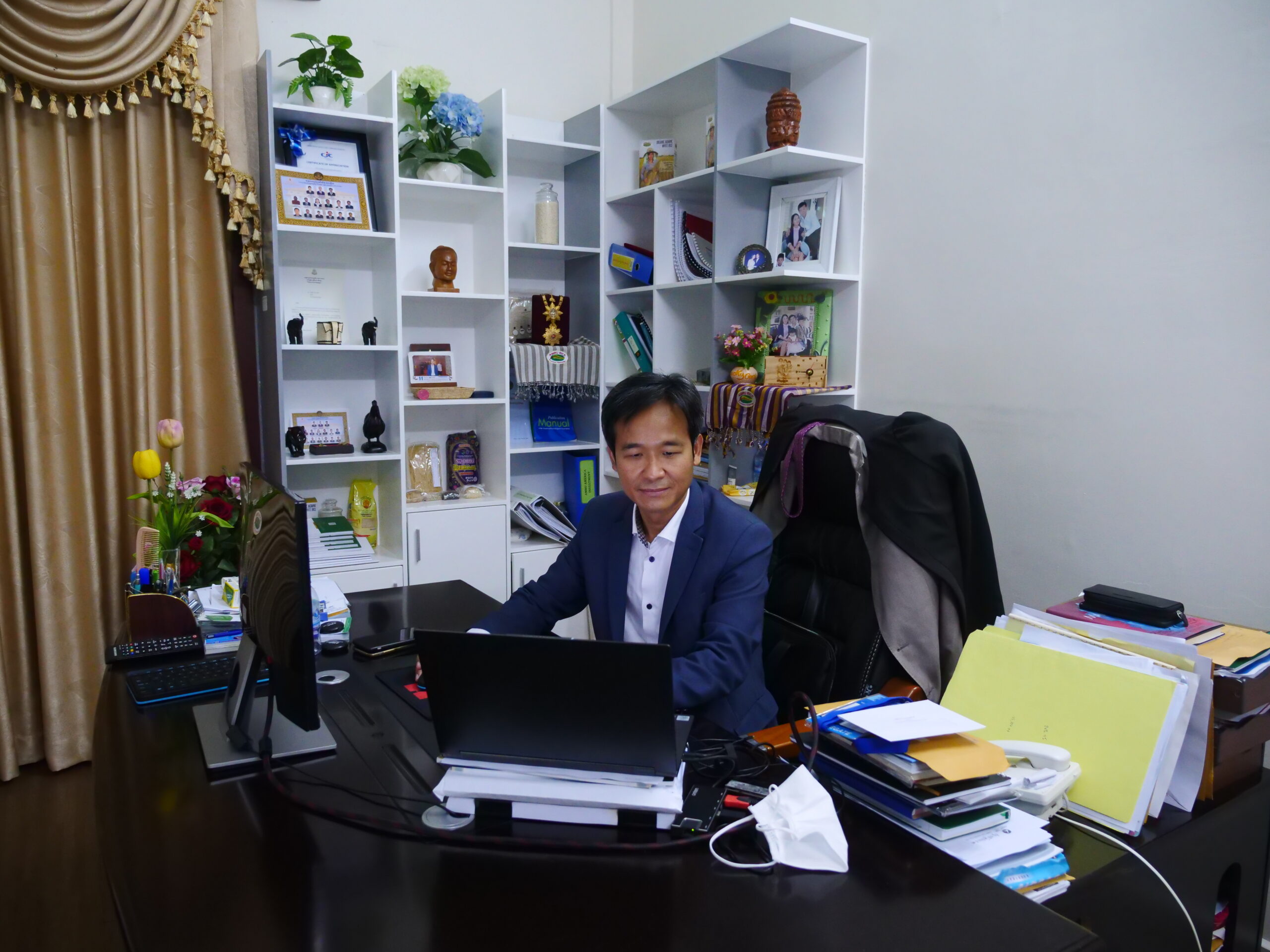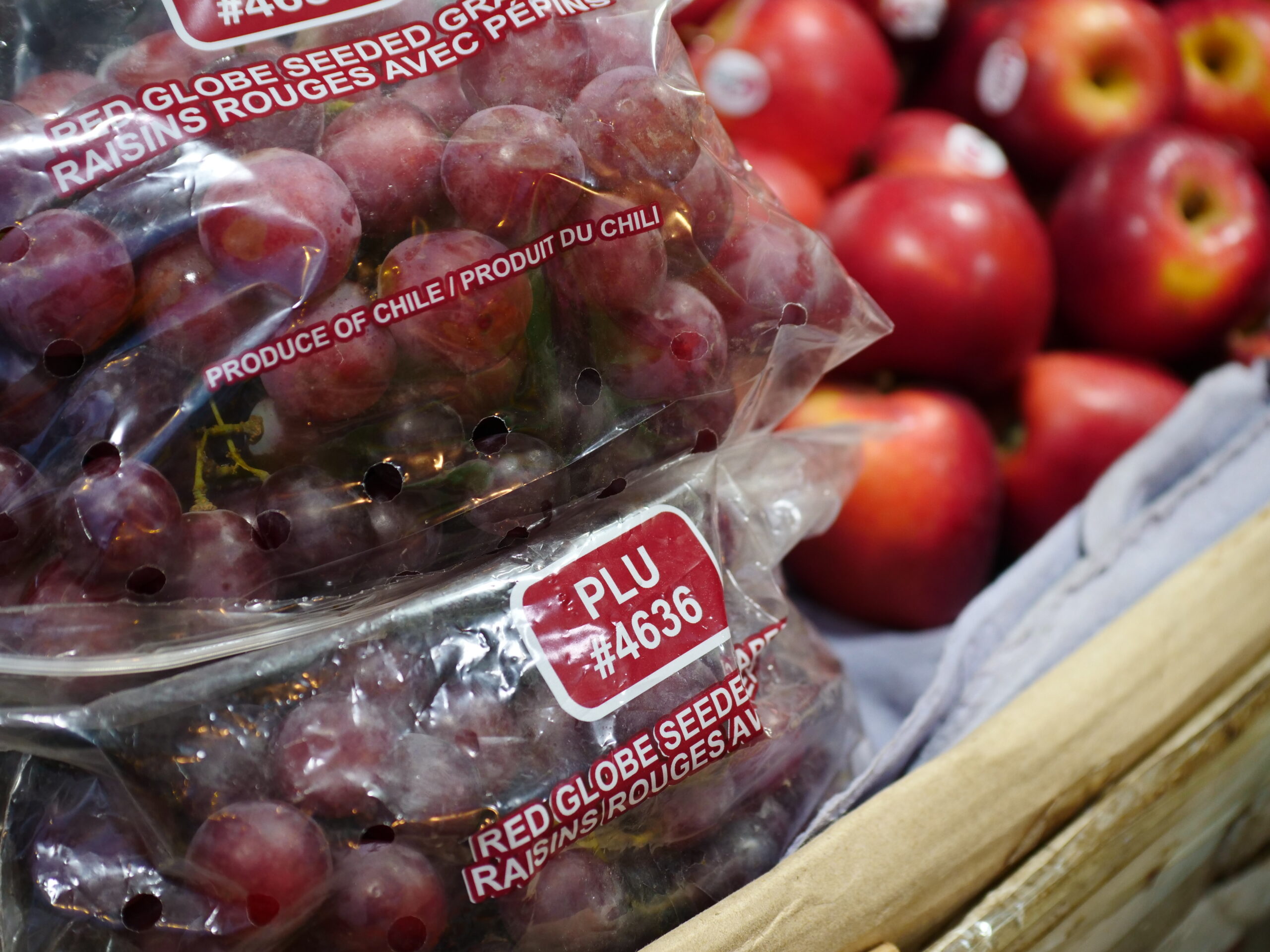Sok Solida’s stall in Phnom Penh’s Daeum Kor wholesale market overflows with fruits and vegetables, but almost none come from Cambodia.
“You can hardly find anything locally produced in this market,” Solida said.
Solida sells longan from Thailand, Chilean red grapes, Chinese pears, Vietnamese oranges and dragon fruit. Only her green bananas are Cambodian products.
The stall’s composition reflects the major challenges for Cambodia’s agriculture sector, where markets are dominated by imported fruits and vegetables and the Kingdom’s farmers struggle to connect with global markets. Between 2014 and 2018, 84% of processed agricultural products and food sold in Cambodia was imported.
Industry analysts, entrepreneurs and government officials argue Cambodia has plenty of potential to take back ownership of its domestic agricultural markets and find international buyers. But this requires key structural changes including adding product value, aligning the needs of vendors and farmers, improving food processing within Cambodia and infrastructure investment to support emerging supply chains.
While agriculture still employs more than one third of the population and has historically been the backbone of Cambodia’s economy, its share of GDP has declined in the past 10 years from 33.5% to nearly 20%.
As agriculture’s share of GDP wanes, the Kingdom’s management of the transition and integration into the global economy is crucial to the sector’s ability to improve the lives and livelihoods of small farmers, National University of Singapore Professor W. Nathan Green said.
The decline in GDP proportion isn’t necessarily bad. Cambodia has spent the past few decades transitioning into the global economy, allowing industries such as tourism and the garment sector to experience significant growth.
But agriculture’s annual growth rate remained under 2% even before Covid-19, according to a February 2020 report by the Cambodian Ministry of Agriculture, Forestry and Fisheries (MAFF). The UN Food and Agriculture Organisation’s website described the sector as “stagnant,” echoing assessments from other development agencies.
Tapping a thick booklet outlining the Kingdom’s forthcoming agricultural master plan, MAFF Secretary General Srey Vuthy said the government “still considers agriculture the main sector.”

Across the Mekong River from Phnom Penh in Kandal province, the smell of rotting mangoes filled the April air. Walking through her field of 60 trees, Phai Yen explained that letting the mangoes go unpicked was cheaper than the money and time needed to harvest them. The market price for 1 kilogram (2.2 pounds) was less than 100 riel (about 2.5 cents), she said.
While mango and banana are two fruits approved for direct export to China and seen as Cambodian agricultural industry successes, mango sales suffered from a spate of lockdowns in China, significant regional competition and domestic overproduction, according to Chan Sophal, director of the Centre for Policy Studies in Phnom Penh.
Small farmers are too often working “blind,” unclear about the best products to grow or ways to improve their profits, said Dr. Sim Sokcheng, director of the Centre of Policy Research in Agriculture and Rural Development in Phnom Penh.
Sandwiched between the much larger and more developed economies of Thailand and Vietnam, Cambodia’s lack of processing capacity has reduced farmers to selling raw materials for processing by its neighbours, who then sell the final product for greater profit to international buyers, including Cambodia, Sim said.
Processing involves making mangoes into juice, turning cashew fruits into salted and packaged nuts or cleaning and wrapping red peppers in plastic. But the inability to capitalise on processing Cambodia’s produce limits farmer profits and the sector as a whole. Only 10% of agricultural products are processed within Cambodia, according to the Asian Development Bank. Rice accounts for most domestic processing.
“We don’t really have access to the global markets,” said Dr. Nyda Chhinh, a Cambodian agricultural researcher at the Royal University of Phnom Penh. “We use Thailand and Vietnam as the major agents to re-export our products.”
A big reason Cambodian agriculture struggles to compete or build up its own domestic processing facilities is the expense of the tools and technology needed to improve farming capacity. Many basic necessities such as fertiliser or grain for poultry feed must be imported and the high cost of electricity hampers processing and cold storage for produce and meats, agriculture industry analysts said.
Former cashew farmer turned processor In Laihout explained her employees wash, dry and peel the acidic cashew fruits by hand. “It is hard to compete with the Vietnamese products, since they have very modern machines to cut the cashews,” she said.
Although she has received funding from the United States Agency for International Development, Laihout said the cost of investing in a processing machine would involve a microfinance loan with prohibitively high interest rates.
Given the limitations in infrastructure and available resources, along with ranking seven out of 11 in population among Southeast Asian nations, Cambodia should not try to compete directly with its neighbours, said Rebekah Bell, the United Nations Food and Agriculture Organisation (FAO) representative in Cambodia.
“When we’re looking for opportunities for agricultural products from Cambodia, we’re selling into regional markets that already have those products and they’re producing them at higher levels with better value addition, better processing, better packing,” she said.
Bell argued the Kingdom must focus on differentiating its products from those of its neighbours, finding niche markets for exporting higher-quality goods.
Cambodia needs not only to seek export opportunities, but should focus on import substitution, finding ways to reclaim domestic markets by helping farmers with processing, she explained.
Farmers can take simple steps to increase their profits, such as sorting onions by size or learning to dehydrate and then prepare dried onions, which are an essential component in many packaged foods, Bell said.
But to implement these steps to add value and improve competitiveness, farmers need training and direction to understand market standards and requirements. Those changes are contingent on better communication with vendors such as the existing grocer chains operating in Cambodia, industry analysts said.
“The linkage between buyers and farmers, it’s not very strong,” Sophal of the Centre for Policy Studies said. “More organisation and coordination between producers and buyers, overseas or in the country, then farmers can be sure to have a market.”

One of Cambodia’s leading organic rice producers and exporters, Amru Rice (Cambodia) Company Ltd., offers one example of an emerging agribusiness finding ways to tap into global markets, selling approximately 8,000 to 9,000 metric tonnes (8,818 to 9921 tons) of rice annually, mainly to Europe and China.
The company focuses on special brands such as organic rice for babies or people with high blood pressure. In addition to investing in meeting American and European standards, Amru has taken part in a shift towards fragrant rice varieties, which have been boosted by the World Bank’s International Finance Corporation in Cambodia.
CEO Song Saran said another key to Amru’s success has been developing cooperatives, organisations of small farmers planting with the same seeds and coordinating to improve bargaining power when purchasing fertilisers and other necessities.

“When I started to do contract farming for the first time in 2013, no one was interested but it didn’t stop me,” Saran said. “But what I have seen is that the mindset changed and they started to learn, train and follow.”
Given the lingering trauma of the genocidal, communist Khmer Rouge regime, which forced Cambodians into farming groups called sahakaw, “cooperative,” Amru chose to use a different Khmer term, sahakoum, meaning “community.”
Amru began with four cooperatives comprising 100 farms. As the benefits emerged, including Saran’s claim that farmers in Amru cooperatives earn at least 30% more than their peers working independently, the company’s suppliers swelled to 16,000 farmers in 88 cooperatives.
Farmer cooperatives play an essential role in developing stronger, more reliable commercial market connections and enabling contracts with vendors, supermarkets and businesses, while adding profit by processing on location, Bell said.

“It’s really so that producers are producing the right type, size and quality of produce for a known market,” she said. “At the moment, producers produce and hope that they can sell.”
The government attempted to incentivise and support cooperatives through a 2013 law and MAFF Secretary General Vuthy said cooperatives are now “booming.”
More work could be done to strengthen cooperatives such as providing lower interest loan rates and ensuring farming organisations are aware of beneficial policies, said Sok Sotha, president of the Cambodian Farmers Federation Association of Agricultural Producers, which comprises 23 cooperatives across 12 provinces.
“The majority of small farmers earn a meagre income to support the family and are not well organised by the farmer organisations,” he said. “If all those policies are functioning well, we would not be at this level, we would step up to another level for the economy.”
For nascent Cambodian agribusinesses, overcoming the Kingdom’s limited infrastructure is a roadblock to reaching international markets.
Cambodian-owned dried fruit company Misota Food Import Export Ltd. launched in 2017 and invested tens of thousands of dollars in gaining international quality certifications through improvements including facility upgrading and development of supply chain traceability systems, according to Commercial Manager Rattana Phal.
Cambodia’s lack of a deep sea port means food products must be sent to Singapore or another neighbouring country before shipment to Europe or China, which represent Misota’s primary markets, Phal said.
“That brings our shipping prices higher,” he said, adding that the company cannot “compete with price.”
Though not yet turning a profit, Misota has connections with overseas vendors and is optimistic about future prospects, Phal said. Cambodia signed a free trade agreement with China in 2020, leading to greater opportunities for dried mango sales.
Misota’s long-term focus on international quality standards and production sustainability policies can be institutionalised within Cambodia to help more farmers serve vendors and businesses, FAO’s Bell said. FAO is working with the government to develop a food control system with national quality standards.
Another significant government policy would be clearly protecting high quality agricultural land from urban expansion while defining which areas will remain set aside for forest conservation, Bell added.
Large agribusinesses such as rubber plantations have received vast swaths of land across Cambodia through government concessions, often displacing inhabitants and furthering environmental destruction.
Cambodia’s agriculture sector does not need to concentrate on expanding production size but should improve yields on existing agricultural land, Bell stressed. For instance, at 3.7 tons per hectare (2.47 acres), Cambodian rice paddies generate much less than Vietnamese farm production rates of 5.9 tons per hectare.
With a general consensus toward better infrastructure, more farmer-buyer cooperation, crop diversification and processing improvement, the sector’s future will depend on effective government coordination, analysts and agriculture managers said.
“It’s all good things in the plans and in the policies,” Sophal said. “But the challenge is implementation. When it comes to implementation, it requires a lot of commitment.”
Photos by Jack Brook for Southeast Asia Globe. Additional Reporting by Samphors Sao.


